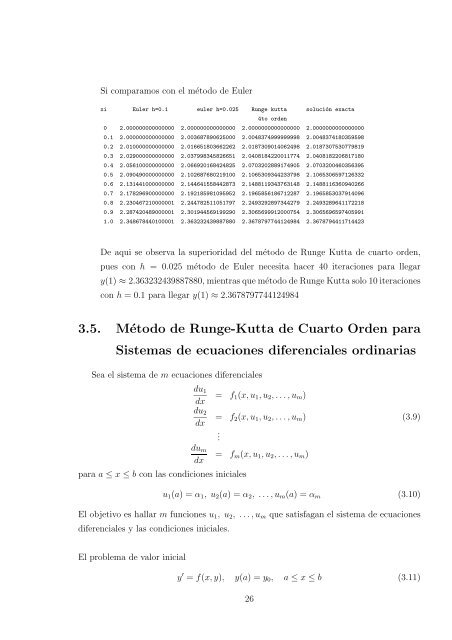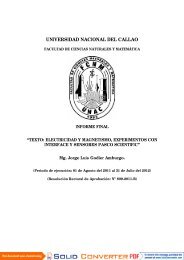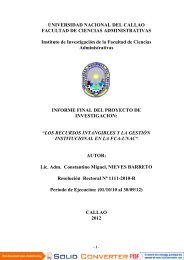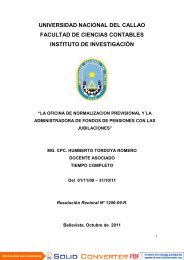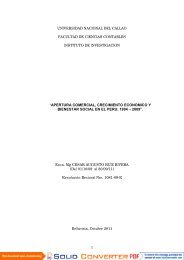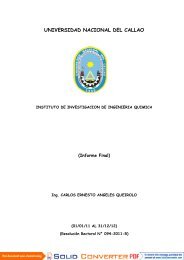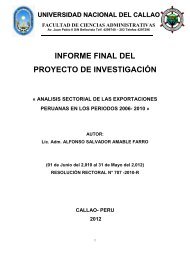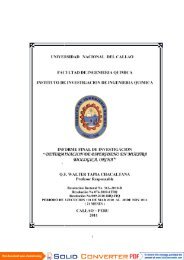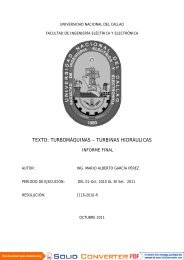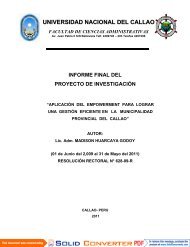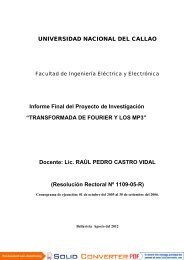texto: metodos numericos para ecuaciones diferenciales ordinarias
texto: metodos numericos para ecuaciones diferenciales ordinarias
texto: metodos numericos para ecuaciones diferenciales ordinarias
You also want an ePaper? Increase the reach of your titles
YUMPU automatically turns print PDFs into web optimized ePapers that Google loves.
Si com<strong>para</strong>mos con el método de Euler<br />
xi Euler h=0.1 euler h=0.025 Runge kutta solución exacta<br />
4to orden<br />
0 2.000000000000000 2.000000000000000 2.0000000000000000 2.0000000000000000<br />
0.1 2.000000000000000 2.003687890625000 2.0048374999999998 2.0048374180359598<br />
0.2 2.010000000000000 2.016651803662262 2.0187309014062498 2.0187307530779819<br />
0.3 2.029000000000000 2.037998345826651 2.0408184220011774 2.0408182206817180<br />
0.4 2.056100000000000 2.066920168424825 2.0703202889174905 2.0703200460356395<br />
0.5 2.090490000000000 2.102687680219100 2.1065309344233798 2.1065306597126332<br />
0.6 2.131441000000000 2.144641558442873 2.1488119343763148 2.1488116360940266<br />
0.7 2.178296900000000 2.192185981095952 2.1965856186712287 2.1965853037914096<br />
0.8 2.230467210000001 2.244782511051797 2.2493292897344279 2.2493289641172218<br />
0.9 2.287420489000001 2.301944569199290 2.3065699912000754 2.3065696597405991<br />
1.0 2.348678440100001 2.363232439887880 2.3678797744124984 2.3678794411714423<br />
De aqui se observa la superioridad del método de Runge Kutta de cuarto orden,<br />
pues con h = 0.025 método de Euler necesita hacer 40 iteraciones <strong>para</strong> llegar<br />
y(1) ≈ 2.363232439887880, mientras que método de Runge Kutta solo 10 iteraciones<br />
con h = 0.1 <strong>para</strong> llegar y(1) ≈ 2.3678797744124984<br />
3.5. Método de Runge-Kutta de Cuarto Orden <strong>para</strong><br />
Sistemas de <strong>ecuaciones</strong> <strong>diferenciales</strong> <strong>ordinarias</strong><br />
Sea el sistema de m <strong>ecuaciones</strong> <strong>diferenciales</strong><br />
du1<br />
dx<br />
= f1(x,u1,u2,...,um)<br />
du2<br />
dx = f2(x,u1,u2,...,um) (3.9)<br />
dum<br />
dx<br />
<strong>para</strong> a ≤ x ≤ b con las condiciones iniciales<br />
.<br />
= fm(x,u1,u2,...,um)<br />
u1(a) = α1, u2(a) = α2, ...,um(a) = αm<br />
(3.10)<br />
El objetivo es hallar m funciones u1, u2, ...,um que satisfagan el sistema de <strong>ecuaciones</strong><br />
<strong>diferenciales</strong> y las condiciones iniciales.<br />
El problema de valor inicial<br />
y ′ = f(x,y), y(a) = y0, a ≤ x ≤ b (3.11)<br />
26


